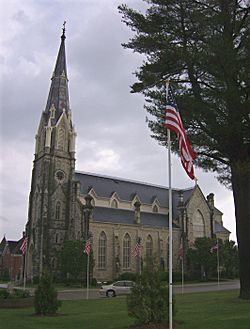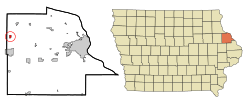New Vienna, Iowa facts for kids
Quick facts for kids
New Vienna, Iowa
|
|
|---|---|

St. Boniface
|
|
| Motto(s):
The eNVy of Iowa
|
|

Location of New Vienna, Iowa
|
|
| Country | |
| State | |
| County | Dubuque |
| Area | |
| • Total | 0.47 sq mi (1.21 km2) |
| • Land | 0.47 sq mi (1.21 km2) |
| • Water | 0.00 sq mi (0.00 km2) |
| Elevation | 1,001 ft (305 m) |
| Population
(2020)
|
|
| • Total | 382 |
| • Density | 819.74/sq mi (316.46/km2) |
| Time zone | UTC-6 (Central (CST)) |
| • Summer (DST) | UTC-5 (CDT) |
| ZIP code |
52065
|
| Area code(s) | 563 |
| FIPS code | 19-56550 |
| GNIS feature ID | 0459494 |
New Vienna is a small city in Dubuque County, Iowa, United States. It's part of the larger Dubuque, Iowa area. In 2020, about 382 people lived there.
New Vienna is famous for its beautiful Saint Boniface Catholic Church. The city even has a fun slogan: The eNVy of Iowa!
Contents
Discover New Vienna's Location
New Vienna is located in Iowa at coordinates 42.548404 degrees north and 91.113568 degrees west.
The city covers a total area of about 0.44 square miles (1.21 square kilometers). All of this area is land, with no water.
A Look Back at New Vienna's History
New Vienna was founded in 1843. It was settled by people from Austria. The Emperor of Austria even helped them get started.
The St. Boniface Catholic Church was built for the families who settled here. This church has a special pipe organ from the late 1800s. It was made by the William Schuelke company. This organ is very rare because it's still mostly original. Only an electric blower has been added since it was first installed.
Who Lives in New Vienna?
| Historical populations | ||
|---|---|---|
| Year | Pop. | ±% |
| 1900 | 245 | — |
| 1910 | 188 | −23.3% |
| 1920 | 241 | +28.2% |
| 1930 | 229 | −5.0% |
| 1940 | 229 | +0.0% |
| 1950 | 204 | −10.9% |
| 1960 | 265 | +29.9% |
| 1970 | 392 | +47.9% |
| 1980 | 430 | +9.7% |
| 1990 | 376 | −12.6% |
| 2000 | 400 | +6.4% |
| 2010 | 407 | +1.8% |
| 2020 | 382 | −6.1% |
| Source: and Iowa Data Center Source: |
||
In 2020, the city had 382 people living in 168 households. Most people, about 97.1%, were White. About 1.3% were Black or African American. A small number, 1.3%, were Hispanic or Latino.
The average age in New Vienna was about 44.7 years old. About 20.7% of the people were under 20. Many people were between 25 and 64 years old. About 22% of the residents were 65 or older. The number of males and females was almost equal.
Schools in the Area
Students in New Vienna attend schools in the Western Dubuque Community School District. Younger students go to Drexler Elementary School and Drexler Middle School in Farley. Older students attend Western Dubuque High School in Epworth.
There are also Catholic schools nearby. St. Francis Xavier Catholic School in Dyersville is a primary school. For high school, students can go to Beckman Catholic High School.
New Vienna used to have its own Catholic primary school called Archbishop Hennessy Catholic School. It closed in 2018.
See also
 In Spanish: New Vienna (Iowa) para niños
In Spanish: New Vienna (Iowa) para niños

